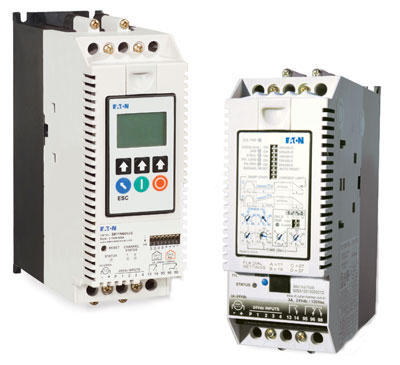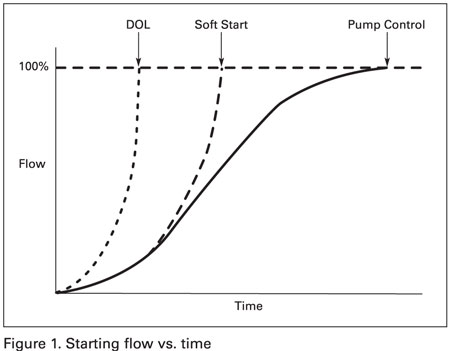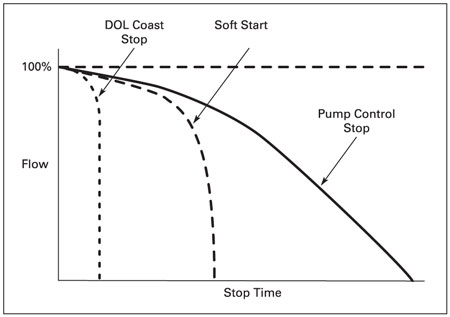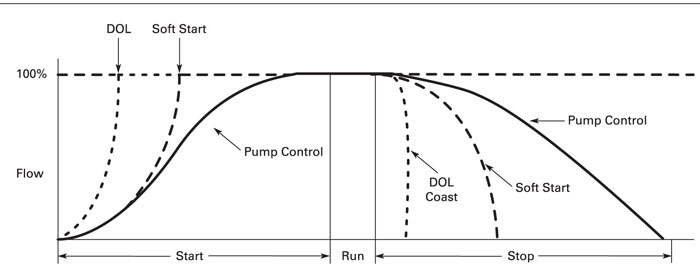Soft starters and VFDs are useful for extending equipment life in HVAC applications.
New solutions are available that are specially designed to reduce or eliminate the potential for water hammer in a pump system, and they use an advanced starting and stopping algorithm developed exclusively for pump control applications. Soft starters can be effectively used to ramp up fans and blowers that are relied upon in HVAC applications. Additionally, variable frequency drives (VFD) can be used in applications that rely on variable speed control to harness energy savings.
 |
| Soft starter with pump control |
Water Hammer and Surges
Surges or pressure transients occur in pumping systems when flow suddenly changes. These surges can result from starting and/or stopping a pump, opening or closing valves and many other sources. A number of mechanical surge reduction techniques are available, but these tend to be costly and complex. Electronic starting and stopping of the pump motor is a cost-effective solution that reduces surges or hammering problems.
When full-line voltage is applied to start a motor that is directly coupled to the shaft, the pump is accelerated from zero to full speed quickly, often in less than ¼ second. This means that the flow from the pump also increases from zero to total capacity just as fast. Fluids are only slightly compressible and have momentum. As a result, the large change in flow over a short period of time can result in high- and low-pressure surges and cavitations as the system seeks equilibrium, which can have unwanted effects.
Specifically, pressure surges can stress the walls of the pipe and cause water hammer or hammering—a loud noise, which sounds like the pipe is being struck with a mallet. The sound is comparatively trivial. The physical damage from high-pressure transients can cause the pipe to burst, while extremely low transients can cause pipes to collapse. Cavitations produce zones of agitated liquid and partial vacuums. The pipe lining may be eroded, and the liquid may be boiled off. These effects also damage valves and fittings.These effects can cause downtime and expense.
Starting and stopping a pump abruptly can result in rapid changes in flow, causing water hammer and pressure surges. By controlling the acceleration and deceleration of the pump motor, these problems can be minimized.
Starting and Stopping Methods
Before comparing starting methods, it is helpful to better define the relationship between the pumping system and pump motor. Change in fluid system pressure is directly proportional to change in motor torque, as the centrifugal pump is often directly coupled to the motor. Motor characteristics can be described in terms of speed/torque curves. Fluid flow is proportional to speed (motor rpm), and pressure is proportional to torque. So, the pump torque requirement and the motor torque curve can be directly compared
The three common methods of starting and stopping a pump motor include:
- Direct online (closing a contactor and applying full voltage to the motor)
- Solid-state reduced voltage starting
- Soft start controllers
Direct Online Starting (DOL)
Often, the motor torque output exceeds pump requirements during the start cycle. Locked rotor torque (LRT) is the torque developed by the motor at the instance of full voltage at the motor terminals at zero speed. LRT can be as high as 180 percent of the motor torque at full speed. Breakdown torque (BT) is the highest amount of torque the motor can develop, which can be as high as 250 percent of full load torque. The difference between the torque produced by the motor and what is required by the load is called accelerating torque.
Accelerating torque causes the motor to rotate the connected load. In the case of the pump, the excessive accelerating torque produced by starting the motor direct online can cause the pump to come up to speed quickly, potentially causing surges or hammering.
Solid State Reduced Voltage Starting (SSRV)
If the period of time when flow changes from zero to 100 percent can be increased, hammering can be reduced. This can be achieved by reducing the amount of accelerating torque delivered by the motor. Less accelerating torque means less force to turn the load and more time required to change the speed of the pump. This can be accomplished by using a solid state reduced voltage starter to slowly ramp the voltage applied to the motor from zero to full voltage over a preset time (typically adjustable from 2 to 30 seconds).
The speed torque characteristics for direct online and SSRV starting of an induction motor may be compared. With SSRV starting, the accelerating torque can be further reduced compared to the direct online method, as the solid state motor controller's can start at a lower value of initial voltage and ramp up to the full voltage value. The torque applied to the motor also ramps up.
At the end of the ramp, however, there is an excessive acceleration torque. This sudden change in torque generates a corresponding burst of speed (flow) at the end of the start cycle and may also result in hammering, as the pump motor rapidly approaches 100 percent speed. This is a result of the breakdown torque that is still present when using a SSRV starter. The sudden surge in pump motor torque at the end of the start cycle can result in a flow surge, due to motor characteristics. It can occur because SSRV starting ramps the voltage up, regardless of the motor's performance. Simply put, SSRV starting improves starting torque characteristics of the pump motor but cannot control the breakdown torque that causes surges.
Soft Start Controllers With Pump Control
Figure 1 compares DOL starting, Solid State Reduced Voltage, and Pump Control starting speed flow vs. time curves. With pump control starting, the surge produced during DOL and Solid State Reduced Voltage can be greatly reduced by the use of advanced algorithm to carefully control the torque output to the motor. As there are no sudden changes in torque, motor acceleration is smooth, and surges and hammering in the system is minimized.

Soft Starter Controllers With Pump Control for Stopping Pump Motors
Stopping the pump is as critical to reducing surges and hammer as starting. In this discussion, examples will be limited to speed (flow) versus time, see Figure 2. When a DOL starter is applied, the pump motor will coast when a stop command is initiated (see DOL Coast Stop in Figure 2). The system head will quickly overcome the motor inertia and the pump will come to a rapid stop. The fluid, which is in motion and has momentum, must come to a complete halt as well. This action causes pressure surges on the pipes and valves, and can cause damage to the system.
In many applications soft stop cannot prevent sudden changes in motor torque required on pumping applications. When a soft stop is initiated, the voltage is ramped from full voltage to zero volts over a time selected by the user (see Soft Stop in Figure 2). Reductions in voltage result in reductions of torque, and the pump begins to slow down. However, a point is quickly reached where the load torque demand exceeds the motor torque supply and the motor stalls. The effect, though not as severe, is the same as slamming a valve closed, and hammering occurs.
There are soft start controllers that can control the deceleration of the pump motor in a method similar to the control of the acceleration. When a stop command is initiated, the controller reduces the motor speed to prevent any sudden changes in torque, minimizing surges in the system. The soft start controllers continue to reduce the torque of the pump motor, resulting in a speed characteristic as illustrated in Figure 2. This type of pump motor deceleration curve results in minimal surges or hammering in the system, as there will not be sudden changes in flow.

Figure 2. Comparison of the DOL, SSRV and pump control stopping characteristics
Soft Starter Controllers With Pump Control for Starting and Stopping Pump Motors
In summary, Figure 3 compares flow versus time when different starting/stopping techniques are used. The soft start controllers with pump control can produce the most desirable flow characteristics, when starting and stopping centrifugal pump motors. No sudden peaks or breaks in flow result in minimizing surges and water hammer in the system.

Figure 3. Comparison of the DOL, SSRV and pump control starting and stopping curves
VFDs in HVAC Applications
While soft starters are able to bring the system to the maximum speed of the motor and keep the system running reliably, variable speed drives can help deliver energy savings by closely matching the speed of the motor to application demands.
Drives can vary the speed of the motor as the application requires. The affinity laws dictate that the power consumed is directly proportional to the cube of the rpm. What that means is a 20 percent reduction in speed cuts down the power consumption by half. VFDs are able to help deliver energy savings and associated cost savings.
Conclusion—Effective Control Keeps Systems Running Reliably
When solving water hammer or surge issues, electrical solutions are often less costly than mechanical ones. The initial cost for the electrical solution tends to be less than that of a specialized control valve and less complex. In addition, the frequent maintenance/system shutdown that can occur with a specialized valve is not required with an electrical solution. Soft starter controllers with pump control are the preferred starting and stopping method for pump systems.
Most soft starters in the industry come with extensive monitoring and protection features, which can eliminate the use of some external devices. This would include phase monitoring, current monitoring and voltage monitoring, among others. Solutions employing VFDs and soft starters can deliver significant energy (and cost) savings and help extend equipment life and reduce maintenance costs.
Pumps & Systems, January 2011


